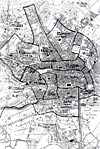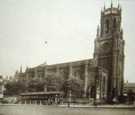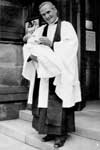For this church:    |
|
THE CORNER STONE |
 The new church The new churchin 1841 |
The building was funded entirely by public subscription. Smiths the Nottingham banking family collectively being the largest contributors with donations in excess of £2,500. J.P. Plumtree, a serving Member of Parliament donated £600, and Henry Godfrey, also an MP, gave £50. The Archbishop of York sent £50 and £100 was received from the estate of the late Richard Arkwright, formerly a resident of the town. The estimated cost of the building was £10,000. Mr J. Ebrank Hall, the building contractor, presented Smith Wright with a silver trowel. The building was completed in 1841 and consecrated on 13 October 1841 by John Kaye, Bishop of Lincoln.
By 1851 Holy Trinity claimed to have the largest congregation in the town with 800 in attendance for the morning service and 1,060 for evensong, plus 350 Sunday School scholars. 412 of the 1,212 seats were free. Pew rents produced considerable income and the church enjoyed the annual interest on the endowment of £32 12s 0d per annum. Pew rents were still being collected until the church closed in 1956. The pew rental, originally 2s 6d per quarter in 1841, was increased to 5s a quarter at the turn of the century and remained at that level until 1956, when the total collected was just £15 for the year. The pew rent accounts show that towards the end of the Holy Trinity’s life most of the pew tenants were spinsters. An endowment fund of £1,000 and a repairs fund of £500 were also established by the time the church was dedicated.
 Map of Nottingham Map of Nottingham parishes in 1865 |
Originally designated a church district of St. Mary’s, Holy Trinity was granted full parish status in 1842. In part this was due to the rapid building development programme initially to the immediate east of the church, where the housing consisted of densely packed poor quality dwellings for the workers who were flooding into the town from the surrounding villages in search of work in the expanding textile factories that shared the land becoming available in both the parishes of St. Mary’s and Holy Trinity. On the opposite side of the road facing the east window of Holy Trinity one reporter wrote 'the fashionable and well to do favoured Holy Trinity, but a few yards across the road lay festering streets of notorious slums, a Music Hall, plus an assortment of brothels, gin palaces and squalid tenements'.
In the northern part of the parish better class housing occupied by people who could afford servants soon followed. Whilst the parish records clearly show that Holy Trinity always catered for its mixed class parishioners it soon became a fashionable church attracting part of its congregation from adjacent parishes. This was one of the factors which allowed Holy Trinity to open day schools in 1847 and fulfil other growing social needs within its parish. A site for a vicarage was sought during the building of the church, but it was thought that the working class area was unsuitable and the first vicarage was eventually built on the Ropewalk in the parish of St. James. It was located next to the Park Waterworks building (constructed later) which is extant, but the vicarage is no more. By 1895 the vicarage was located briefly on Goldsmith Street before moving to Arboretum Street with both addresses in the parish. In 1859 the parishioners funded the building of St. Stephen's church, Bunkers Hill, only a few hundred yards from Holy Trinity. It was located within the poor part of the parish. Built as a chapel-of-ease it eventually acquired parish status.
The Vestry Books of Holy Trinity record the range and quantity of work the church sponsored and promoted at a time when the Welfare State was not even a concept to be considered by most people. At the forefront of the parish work was the establishment of educational opportunities for children. The first school was opened in 1847 just six years after the church was founded. By 1854 the Annual School Report stated that the roll totalled boys 1,383, girls 670, infants 1,336. This increased in 1855 to boys 1,488, girls 700, infants 1,548. The lower number of females attending school tells its own story. The Sunday Schools had weekly attendances of 558 in 1854, reducing to 488 in 1855.
To accommodate these numbers several buildings were needed. These were located at different times on Trinity Street, Bunkers Hill, Colville Street, Burton Street, Sherwood Street and Shakespeare Street. Several of these premises were owned and maintained by the church. Others were rented. A stark reminder of the nature of the health issues affecting the school is recorded in 1868 when two pupil teachers died, one of consumption the other of typhus. That year the schools employed 21 pupil teachers.
By the 1870s a rented mission building, costing 15 shillings a quarter, was operating at number 172 North Sherwood Street, close to the western boundary of the parish, and remained active until 1897 when falling congregations and other uses led to its closure. In its earlier days it was used as a Sunday School and for weekly Sunday evening services. It also hosted a range of social activities such as a Men’s group, bible classes and young people’s clubs. The building is no longer extant.
The Colville Street premises were also used for more than schooling. Initially opened as a school for infants in the 1850s it survived under Holy Trinity management until the early 1924 when the Nottingham Education Committee built a new school nearby. Part of the site of the old building was sold and the proceeds used to build a new church hall in the 1930s on the retained part of the site. From this time most of the activities organised by the church were transferred to the new building. A photograph of the interior of the main hall shows that it was wide enough to accommodate rows of at least 13 chairs with spacious aisles on each side. Total seating capacity was 380, it had high side walls and a curved ceiling with the windows set just below the eaves. A curtained stage occupied one end. A smaller Committee Room could accommodate 75. This building continued in use until the demise of Holy Trinity. It was later used by other groups for worship, but has since been demolished.
Holy Trinity’s Parish magazine was titled Parish Leaves. Its pages contain a wealth of information about the many activities and services initiated and maintained by the church. These include: Working men’s classes, formed February 1854, evening classes for reading and writing, a well-stocked library, weekly subscription one half penny, savings club, clothing club, a Laying-in charity for poor women, 58 women were relieved in 1855 rising to 64 in 1867 In the same year 295 items of clothing were distributed to infants of the parish 320 given out in 1867.
There was also a Blanket Loan Charity: 500 blankets were loaned out in November 1853 and all were returned freshly laundered in May 1854. The ladies' Dorcas group then spent the summer repairing them.
Mothers' meetings were also organised where mothers were taught how to sew. Accounts also show that the church financially supported various Christian groups including: the Church Pastoral Aid Society, the Ladies Home Mission, the Church Missionary Society, the China Inland Mission and the British and Foreign Bible Society. Other donations were also regularly requested for specific purposes. On one such occasion the vicar asked for money to buy boots for some of the poorer children of the parish who had no footwear, £2 11s 6d was collected enabling 11 pairs of boots to be purchased and distributed. A working Men’s Hall is mentioned in 1867, but neither its location nor the activities it supported are listed.
A major development in 1892 seriously impacted on the future of Holy Trinity. This was the proposed construction of a new railway line through the town and the building of a large station sited to the east of the church and only a few yards away. A large triangle of land was needed which was at the time mostly occupied by poor quality housing and industrial premises.
St. Stephen's church, formerly a chapel of ease to Holy Trinity, occupied part of the proposed clearance site. Some 10,000 residents were to be moved and rehoused elsewhere within the town. Many were moved to Sneinton, Radford and St. Ann’s. A new church, St. Catherine’s, was opened in the latter area. The more affluent area of the parish to the west was unaffected. At the same time (1896) Nottingham City Council negotiated to buy part of Holy Trinity churchyard, taking land on all four sides to lay out a new square to be known as Trinity Square. A new wall was built around the site and £6,500 was paid as compensation.
Of the early part of the 20th century we have fewer records. Pew rents declined, and strangers were allowed into the church after the vicar had entered. The churchwardens, members of the Parish Council and many of the congregation did not all live in the parish. The pew rent ledger records addresses in adjoining parishes including St James, All Saints, St. Mary’s, St. Andrew’s and others not so close.
In 1912 there were 580 children on the roll of the church school, and 500 on the roll of the Sunday School. There were 82 baptisms and 41 confirmations in 1911-12.
The memorial to the men of the parish and church who lost their lives in the 1914-1918 war shows 92 names.
The expansion of Local Authority educational provision and the removal of so many parishioners resulted in the closure and sale of the Shakespeare Street and Burton Street schools in 1924.
One positive event was in 1931 when the parish of St. James, Standard Hill was united with Holy Trinity. This parish was home to more the more affluent members of the town, several of whom already worshipped at Holy Trinity and served on the Holy Trinity Parish Council.
In 1935 a proposal was made that Holy Trinity should be demolished, this was part of a wider debate concerning the future of several city centre churches. A possible use of the site was put forward. The tower was to remain and the rest of the site cleared, becoming a Garden of Rest. Holy Trinity was spared but St. James fell under the demolition hammer. By this time the number of people living in the city centre was much reduced with domestic housing giving way to commerce and industry. In 1937 part of the parish of nearby St Mark's Church was united with Holy Trinity. St. Mark's Church was another victim of the demographic changes in the city.
 The church after The church afterthe spire had been removed in 1942 |
By January 1942 the condition of the spire was causing concern. The stonework was cracked in several places and although it was commonly believed the damage was due to German bombing experts concluded it was instead due to the rusting and perishing of the ties securing the stones, which were of iron instead of more durable copper. A subscription fund was established to meet the cost of dismantling the spire with the intention of rebuilding it when conditions were more favourable. It was taken down in the summer of 1942 but two years later the vicar, the Rev Harry Holden, when asked if the spire was ever going to be rebuilt replied 'no, it will cost too much, but I would like to put up a big Neon cross in the tower.' In February 1946 the Nottingham Journal reported that the spire stonework was for sale.
An order closing Holy Trinity was made in 1956. The final services were held on 8 July 1956. At the morning service the Archdeacon of Nottingham, the Ven J. H. L. Phillips, told the large congregation that
'Churches are not museum pieces. They are temples of the living God ... if their time of service and usefulness is over in one place it is only right that they should die, in order to live again in another place. It is that, is it not, which takes the sting out of this farewell Sunday at Holy Trinity?'
 The Rev H Holden The Rev H Holdenafter performing the last baptism at Holy Trinity in June 1956 |
The evening preacher was the vicar, the Rev. Harry Holden, who said that the closing of the church was a real sacrifice for the new community at Clifton.
The building and the site was sold to Nottingham Corporation for the sum of £72,000. Demolition costing £2,000 followed in the Spring of 1958. Most of the contents removed were taken to the new Holy Trinity Church on the Clifton housing estate. Few remain today. The proceeds of the sale were allocated to St. Mary’s Church High Pavement. The parish was divided between St. Andrew’s Mansfield Road, St Peter’s Wheeler Gate and All Saints Raleigh Street.
After the site had been cleared a multi-storey municipal car park was built. This structure has since been demolished and replaced with a more modern car park and shops. In 2013 the public square once again is to be remodelled.
The Records of Holy Trinity Church are held by Nottinghamshire Archives:
Baptisms – 1842-1956
Marriages – 1842- 1956
Burials – 1843- 1926





